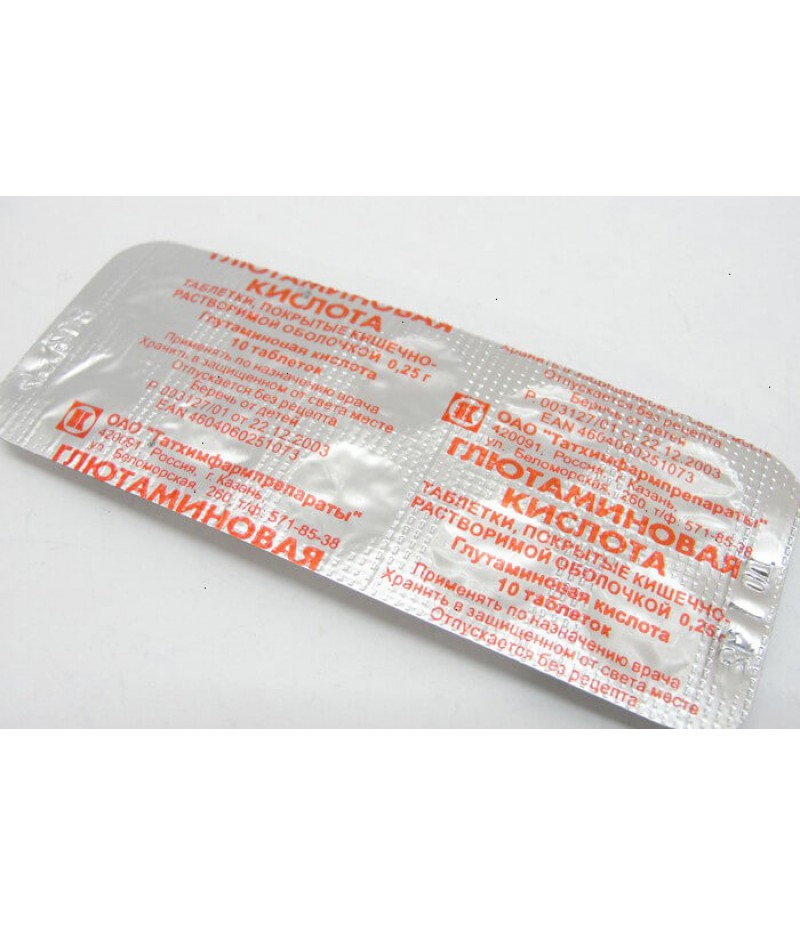Glutamic acid tabs 250mg #10
- $2.99
- 3 or more $2.95
- Availability:In Stock
Glutamic acid user manualReed more and buy Glutamic acid on this pageCompositionGlutamic acid contains 250 mg of the active substance of the same name in the composition of one tablet.Additional substances: povidone, potato starch..
Tags: tabs
Glutamic acid user manual
Reed more and buy Glutamic acid on this page
Composition
Glutamic acid contains 250 mg of the active substance of the same name in the composition of one tablet.
Additional substances: povidone, potato starch, calcium stearate monohydrate, talc.
Shell composition: talc, sucrose, titanium dioxide, silicon dioxide, povidone, liquid paraffin, beeswax.
Release form
White biconvex tablets of a round form, two-layer on cross section.
10 tablets in a cellular package; one pack in a pack of paper.
60 tablets in a polymer can; one can in a pack of paper.
pharmachologic effect
Nootropic action.
Pharmacodynamics and pharmacokinetics
Pharmacodynamics
Pharmacopoeia indicates that this drug improves the metabolism of cells of the nervous system. The structural formula of glutamic acid is C5H9NO4. Replaceable amino acid in the body is present only in the levogyrate form (L glutamic acid). It acts as a mediator with pronounced metabolic activity in brain tissue, activates redox reactions in the brain, as well as protein metabolism. Regulates the metabolism, transforming the functional status of the endocrine and nervous systems. Stimulates the transfer of excitation in the synapses of neurons, helps to neutralize and evacuate ammonia from the body, increases resistance to hypoxia.
An important component of myofibrils, a component of the synthesis of other amino acids, ATP, acetylcholine, urea, helps to transfer and maintain the required content of potassium ions in brain tissues, mediates between the metabolism of nucleic acids and carbohydrates, and normalizes the level of glycolysis in tissues. It has a hepatoprotective effect, inhibits the secretory function of stomach cells.
Pharmacokinetics of Glutaminic acid
Has a high degree of absorption of high. It overcomes histohematogenous barriers, membranes of subcellular structures and cell membranes. It accumulates in the liver, kidneys and soft tissues. Excreted in the urine (5-7%) in its original form.
Indications for use
Indications for use of glutamic acid (with complex therapy):
inhibition of mental development of various etiologies, cerebral palsy, consequences after birth injury, polio, Down syndrome;
schizophrenia, epilepsy (minor seizures), psychosis, depressive reactive state, insomnia, mental exhaustion, the effects of encephalitis and meningitis, progressive myopathy, depression;
toxic neuropathy with the use of isonicotinic acid derivatives.
Contraindications
Increased excitability, feverish conditions, oppression of blood formation in the bone marrow, violent mental reactions, insufficiency of the kidneys or liver, anemia, peptic ulcer, obesity, nephrotic syndrome, hypersensitivity to glutamic acid.
Side effects
The following symptoms may develop: loose stools, vomiting, allergic reactions, nervous agitation, nausea, abdominal pain, irritability. With prolonged use often develop: leukopenia, a decrease in hemoglobin content, cracks in the lips, irritation of the mucous membranes of the mouth.
Instructions for use of glutamic acid (method and dosage)
The drug is taken orally for half an hour before meals, when symptoms of dyspepsia appear, is used after or during the meal.
Glutamic acid, instructions for use
Adult patients are prescribed 1 gram of the drug up to three times a day.
Children up to 1 year prescribed 100 mg per day.
Up to 2 years, appoint 150 mg per day.
Children 3-4 years prescribed 250 mg per day.
Children 5-6 years prescribed 400 mg per day.
Children 7-9 years prescribed 500-1000 mg per day.
Children from 10 years old appoint 1000 mg to three times a day.
When oligophrenia prescribed means at the rate of 100-200 mg per kilogram of weight.
The duration of treatment is usually from 1-2 months to 1 year.
Overdose
Possible increased side effects in the event of acute drug poisoning. Symptomatic treatment, gastric lavage, the use of enterosorbents.
Interaction
Together with Thiamine and Pyridoxine, the drug is used for the prevention and treatment of neurotoxic disorders caused by the intake of isonicotinic acid derivatives.
In muscular dystrophy and myopathy, the drug is effective in combination with Glycocol or Pachicarpine.
Terms of sale
You don't need a prescription to buy Glutaminic acid.
Storage conditions
Store at room temperature in original packaging. Keep out of the reach of children.
Shelf life - 4 years.
special instructions
It is necessary to use with caution in liver disease.
With the development of side effects reduce the dose of the drug.
During therapy, it is necessary to monitor the parameters of urine and blood.
For children
Children up to 1 year prescribed 100 mg per day.
Up to 2 years, appoint 150 mg per day.
Children 3-4 years prescribed 250 mg per day.
Children 5-6 years prescribed 400 mg per day.
Children 7-9 years prescribed 500-1000 mg per day.
Children from 10 years old appoint 1000 mg to three times a day.
During pregnancy and lactation
This tool is not used during pregnancy and lactation.
Glutamic Acid Reviews
Reviews of glutamic acid show that the drug is used only in combination with more potent drugs and is more similar in action to dietary supplements. The evidence base of the benefits of the drug in a particular pathology is weak. Glutamic acid is used separately in sports and bodybuilding.
Glutamic acid in bodybuilding and in sport
The drug is often included in the composition of nutrition in athletes to increase efficiency. It helps to recover faster after strong physical exertion, as it reduces intoxication with metabolic products and has a weak anabolic effect.

